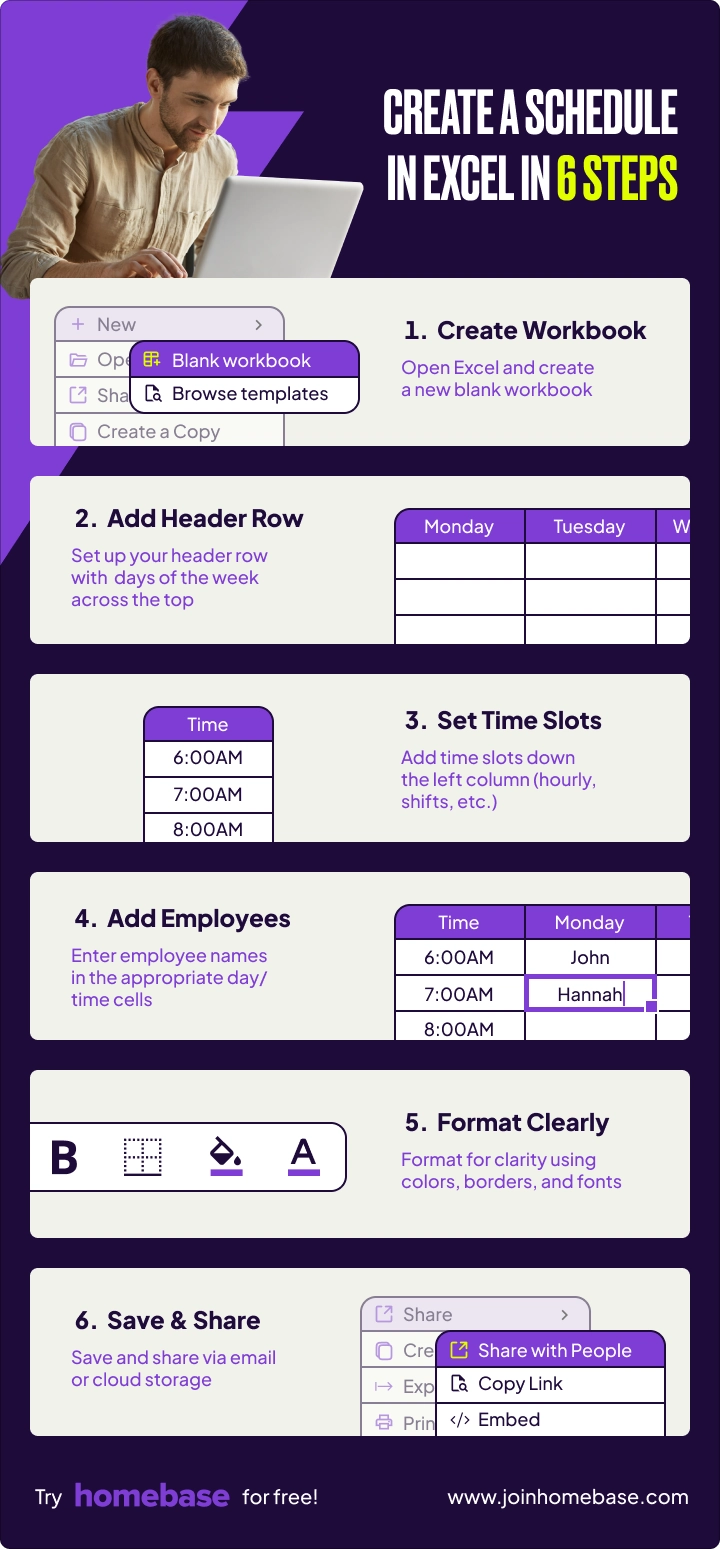
Need a team schedule right now that you can quickly share with your employees? If you're already using Microsoft Office, learning how to make a schedule in Excel gives you a stop gap before you have to sit down and learn new software.
In this guide, we'll walk you through the step-by-step process of building a functional schedule in Excel, plus share tips for more complex scheduling needs. We'll also introduce you to purpose-built scheduling tools that eliminate the headaches of spreadsheet scheduling (like having to text or email your team every time you change a shift! That should be automated!).
Ready to take the "ugh" out of sched"ugh"ling? Let's get started.
TL;DR: How to Make a Schedule in Excel in 6 Steps
In a hurry? Here's the quick version:
- Open Excel and create a new blank workbook
- Set up your header row with days of the week across the top
- Add time slots down the left column (hourly, shifts, etc.)
- Enter employee names in the appropriate day/time cells
- Format for clarity using colors, borders, and fonts
- Save and share via email or cloud storage

For more detailed instructions and tips, continue reading below.
How to create a schedule in Excel
While Excel may be specifically designed for data entry and financial analysis, you can totally use it to design custom schedules for your business.
Not familiar with the platform? No problemo. With these step-by-step instructions, you’ll be whipping up your team schedule in no time.
Step 1: Launch Excel
Launch Microsoft Excel on your computer. If you don't have Excel installed, you can use the online version or any other spreadsheet software that you prefer
- Select a blank workbook.
- Click create.
Step 2: Insert header
- Click on the top row of your spreadsheet to select it.
- Then, right-click and choose "Insert" to create a new row at the top.
- In this newly inserted row, add your header information.
- Include details such as your business name (or location), department, and the time period covered by the schedule.
- For example: Restaurant A (Weekly schedule for January 1-8)
Step 3: Title your columns and rows
- Label the columns with the days of the week.
- The rows should represent specific time slots. This can be done hourly or divided into morning, afternoon, and evening shifts.
- For hourly increments, start from the top with labels like "8:00 AM," "9:00 AM," and so on.
Note: If your scheduling needs are more basic, morning, afternoon, and evening shifts will suffice, but be sure to include specific start times to eliminate any confusion.
Step 4: Input employee names
Once you’ve accurately labeled the columns and rows, it’s time to fill out the schedule.
- Let's say you've scheduled Employee A on Monday with a start time of 8 am. At the intersection of Monday and 8 am, insert the employee's name
- You can use different colors or formatting options to make the schedule visually appealing and easy to understand. For instance, small teams may want to assign each employee a specific color, while larger teams may want to assign certain colors for specific shifts
Note: Excel provides tons of formatting options! Experiment with cell formatting, borders, and colors to distinguish between days, shifts, or different types of tasks. It can make it easier for your team to interpret the schedule at a glance.
Step 5: Save your work
Save as you go to prevent your hard work from vanishing before your eyes!
But it’s most important to save your file once you've completed your work schedule.
- Include the relevant dates in the file name to make it easy to find. Ex: Weekly_Schedule_January1-8.
Pro tip: If you use the same scheduling cadence every week, save your file as a scheduling template before you populate it with employee names!
Step 6: Share and distribute
Depending on your team's preferences, you can share the Excel schedule by:
- Emailing the file
- Using cloud storage services
- Printing physical copies
Provide a few ways to obtain a copy of the schedule to ensure it’s accessible for all members of your team.
By following these detailed steps, you can easily make a work schedule in Excel that suits the unique needs of your team.
Does Excel Have a Scheduling Template?
Yes, Excel does has built-in scheduling templates that can save you even more time. These templates provide a foundation for creating work schedules, shift schedules, and other types of time management tools without starting from scratch.
To access Excel's scheduling templates:
- Open Excel and click "New"
- Type "schedule" in the search bar
- Browse available templates including employee shift schedules, work schedules, and project schedules
- Select and download the template that best fits your needs
While these templates are a great starting point, you'll likely need to customize them.
How to Create a Calendar Schedule in Excel
If you prefer a traditional calendar view:
- Use Excel's calendar templates: Start with a pre-built calendar template
- Create a monthly view: Set up a grid with 7 columns (for days of the week) and 5-6 rows (for weeks)
- Add date formulas: Use the formula:
=DATE(year,month,day) - Format dates properly: Right-click, select "Format Cells," and choose an appropriate date format
- Add schedule details: Enter appointments, shifts, or events directly into the calendar cells
- Create a color legend: Use different colors for different types of events or shifts
How to Make a Rotating Schedule in Excel
Rotating schedules are particularly challenging but possible in Excel:
- Create a base pattern: Design your initial rotation pattern (e.g., Day, Swing, Night, Off)
- Set up employee rows: List employees down column A
- Enter the initial rotation: Fill in the first complete rotation cycle for each employee
- Copy and shift patterns: For each new rotation period, copy the previous pattern and shift it according to your rotation rules
- Use formulas to advance shifts: Create formulas that automatically adjust each employee's position in the rotation
- Add conditional formatting: Highlight different shifts with distinct colors
Benefits of using Excel to make your work schedules
Beyond complicated formulas, Excel offers built-in templates and scalable features that simplify team scheduling.
- Saves Time: Create schedules quickly using built-in templates, formulas, and copy-paste functionality.
- Flexible Features: Easily adjust shifts, add employees, or modify schedules on the fly as your needs change.
- Accurate Calculations: Automatically calculate total hours worked to avoid overscheduling and ensure labor law compliance.
- Data Analysis: Track scheduling patterns over time to make smarter decisions about staffing and resource allocation.
- Easily Shareable: Distribute schedules via email or cloud storage so your team can access them from anywhere.
- Scalability: Adapt your scheduling approach whether you're managing 5 employees or 50, even with seasonal fluctuations.
- Visual Clarity: Use color coding, formatting, and highlighting to make schedules instantly understandable.
- Accessibility: Create schedules on your desktop while employees view them on any device they prefer.
- Cost-Effective: Leverage software you already own instead of purchasing specialized scheduling tools.
That said, you can get a lot of these benefits from an automated tool like Homebase, too! With the added bonus of scheduling templates, managing PTO, clock ins, and integrated payroll. Check out Homebase scheduling!
The downside of creating your work schedule in Excel
Despite its many advantages, Excel has several downsides that are worth considering before making it your go-to scheduling solution.
- Limited Automation: Most scheduling tasks require manual data entry and calculations, leading to more time spent and potential errors.
- Version Control Issues: Without real-time updates, team members may accidentally use outdated schedule versions, causing confusion.
- Time-Consuming Updates: Accommodating shift swaps, time-off requests, and staffing changes requires tedious manual adjustments.
- Basic Reporting: Excel lacks the advanced analytics and reporting features found in dedicated scheduling software.
- Security Concerns: Sharing Excel files containing employee information may pose data security and privacy risks.
- Learning Curve: New users face challenges with Excel's formula-based functionality, especially when building complex schedules.
- Compatibility Problems: Sharing schedules with team members using different software versions or devices can create formatting and access issues
And scheduling right can make or break a business! When you break labor laws (miss overtime, don't schedule enough down time between shifts, etc.), you could be in financial trouble. We built Homebase to automatically notify you when employees creep towards OT, and manage compliance for you.
Is there a better way to create work schedules for your employees?
While Excel works for basic scheduling needs, it wasn't designed to handle the dynamic scheduling challenges that hourly teams face every day. Purpose-built scheduling tools like Homebase remove the friction that prevents your team from being unstoppable.
As one business owner puts it: "Homebase makes it simple to quickly create schedules with multiple employees on rotating shifts. If any updates are made that create a conflict in the schedule, Homebase identifies and warns of those conflicts."
Why Teams Are Switching from Excel to Homebase
- Create Schedules in Minutes: Reclaim your nights and weekends by using templates and auto-scheduling instead of rebuilding Excel spreadsheets from scratch every week.
- Instant Schedule Updates: Eliminate the "I didn't know I was working" excuse forever with automatic notifications via text, email, and app when schedules are published or changed.
- Employee-Driven Shift Management: End the endless phone tag by letting your team claim open shifts themselves instead of spending your Sunday night making desperate calls for Monday coverage.
- Built-In Time Off System: Ditch the sticky notes and forgotten conversations by centralizing all time off requests in one organized system that prevents confusion.
- Sales-Based Scheduling: Protect your profits by scheduling based on actual sales data, ensuring you're never over or understaffed during critical business hours.
- Personalized Shift Notes: Stop repeating yourself by adding specific instructions directly to shifts so your team knows exactly what to do without constant supervision.
- Mobile Access For Everyone: Meet your team where they live – on their phones – whether they're tech-savvy teens or smartphone newbies.
- Real-Time Communication: Connect with your entire team instantly during emergencies or unexpected rushes without relying on group texts that get lost.
- Smart Conflict Prevention: Automatically track availability and prevent scheduling conflicts with school, second jobs, and family commitments.
What Businesses Are Saying About Making the Switch
"I used to struggle with an excel spreadsheet trying to do schedules, Homebase saves me hours and scheduling mistakes." - Shakespeare Corner Shoppe
"Homebase has made it very easy for my employees to pick up shifts and take charge of their own schedules. It's reduced a lot of scheduling overhead for us so we can spend our time more wisely." - WRTS Franklin Park
"As a wedding venue, there are a lot of roles to coordinate in order to execute a seamless event and Homebase helps us verify that the right staff is showing up at the right time each and every day." - The Brownstone Wedding & Event Venue
The best part? Homebase's basic scheduling features are completely free for small businesses, making it an easy decision to upgrade from Excel spreadsheets to purpose-built scheduling software that makes your team unstoppable.
Ready to reclaim the time you're spending on Excel scheduling? Try Homebase for free.
Share post on

Homebase Team
Remember: This is not legal advice. If you have questions about your particular situation, please consult a lawyer, CPA, or other appropriate professional advisor or agency.
Popular Topics
Homebase is the everything app for hourly teams, with employee scheduling, time clocks, payroll, team communication, and HR. 100,000+ small (but mighty) businesses rely on Homebase to make work radically easy and superpower their teams.




